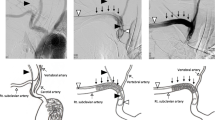Abstract
We report a case of posterior wall hematoma formation in the internal jugular vein after the puncture of central vein. An 82-year-old woman was scheduled for laparotomy for an abdominal incisional hernia. After induction of general anesthesia, we performed central venous catheterization via the right internal jugular vein under ultrasound guidance in the short-axis view and out-of plane technique. The ultrasound view after insertion of a guide-wire revealed a hematoma-like space on the posterior wall of the vein. We removed and reinserted the guide-wire. This time, insertion of the wire and catheter was uneventful. Seven days after the surgery, no hematoma-like space was found in the vein. The malposition of the guide-wire was detected before dilation, which enabled us to avoid complications in this case. We should note that the confirmation of guide-wire placement in the vein is important during ultrasound-guided central venous catheterization.

Similar content being viewed by others
References
Miller AH, Roth BA, Mills TJ, Woody JR, Longmoor CE, Foster B. Ultrasound guidance versus the landmark technique for the placement of central venous catheters in the emergency department. Acad Emerg Med. 2002;9:800–5.
Thompson C, Barrows T. Carotid arterial cannulation: removing the risk with ultrasound? Can J Anesth. 2009;56:471–2.
Parsons AJ, Alfa J. Carotid dissection: a complication of internal jugular vein cannulation with use of ultrasound. Anesth Analg. 2009;109:135–6.
Blaivas M, Brannam L, Fernandez E. Short-axis versus long-axis approaches for teaching ultrasound-guided vascular access on a new inanimate model. Acad Emerg Med. 2003;10:1307–11.
Troianos CA, Hartman GS, Glas KE, Skubas NJ, Eberhardt RT, Walker JD, Reeves ST. Guidelines for performing ultrasound guided vascular cannulation: recommendations of the American Society of Echocardiography and the Society of Cardiovascular Anesthesiologists. Anesth Analg. 2012;114:46–72.
Stone MB, Moon C, Sutijone D, Blaivas M. Needle tip visualization during ultrasound-guided vascular access: short-axis vs. long-axis approach. Am J Emerg Med. 2010;28:343–7.
Blaivas M, Adhikari S. An unseen danger: frequency of posterior vessel wall penetration by needles during attempts to place internal jugular vein central catheters using ultrasound guidance. Crit Care Med. 2009;37:2345–9.
Gibson F, Bodenham A. Misplaced central venous catheters: applied anatomy and practical management. Br J Anaesth. 2013;110:333–46.
Author information
Authors and Affiliations
Corresponding author
About this article
Cite this article
Morimoto, Y., Tanaka, E., Shimamoto, Y. et al. Dissection of the posterior wall by guide-wire during internal jugular vein catheterization. J Anesth 29, 289–291 (2015). https://doi.org/10.1007/s00540-014-1900-0
Received:
Accepted:
Published:
Issue Date:
DOI: https://doi.org/10.1007/s00540-014-1900-0




